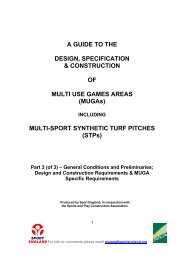View - North East Lincolnshire Council
View - North East Lincolnshire Council
View - North East Lincolnshire Council
Create successful ePaper yourself
Turn your PDF publications into a flip-book with our unique Google optimized e-Paper software.
BOC Immingham Dissolved Acetylene Project Environmental Statement: Vol. 2 Main Text<br />
Safety<br />
3.104 Given the nature of the operations at the proposed site the key driver to the design is safety.<br />
Providing that all safety requirements can be accounted for the design can then be influenced by<br />
other considerations (e.g. sustainability and environmental issues).<br />
3.105 As noted previously, the plant will be designed such that is can meet the requirements of the<br />
COMAH regulations and other current, relevant safety related legislation.<br />
Environmental<br />
3.106 The design of the plant will take into account the environmental requirements in the EIGA code of<br />
practice 15 and associated documentation.<br />
3.107 As noted previously, the plant will be designed such that is can meet the requirements of its EP<br />
and demonstrate the application of BAT.<br />
Sustainability and Efficiency<br />
3.108 The process is inherently efficient in that returnable gas containers are re-used and re-filled (i.e.<br />
they are not disposable cylinders).<br />
3.109 The Project will take into account Policy DM 10 (Adapting to climate Change) and will aim to adopt<br />
a sustainable approach to developing the design. In particular the design has considered<br />
addressing flood risk by adopting a sequential approach to the identification, and development of<br />
sites in accordance with PPS 25 (see Annex 8) such as:<br />
� incorporating appropriate flood mitigation and where necessary flood resilience measures; or<br />
flood warning measures;<br />
� incorporating sustainable drainage systems; and where appropriate, green infrastructure;<br />
� adopting sustainable building techniques (including selection and sourcing of materials) that<br />
promote water and energy efficiency and minimise waste through reduction and reuse; both<br />
during the construction and lifetime of the development;<br />
� adopting sustainable design principles regarding the layout and form of development;<br />
� ensuring consideration is given to the effect of development on biodiversity; and<br />
� supporting renewable energy proposals that contribute to meeting the renewable energy<br />
targets for <strong>North</strong> <strong>East</strong> <strong>Lincolnshire</strong>.<br />
3.110 Examples of how some the points listed above have been considered are discussed below:<br />
� the new plant has been designed to be considerably more efficient than its predecessor in<br />
Bristol. In particularly, buildings will be better insulated to minimise heat loss gain, the footprint<br />
of buildings will be reduced where possible and automatic doors at entrances and exits will be<br />
considered (where appropriate feasible) to minimise heat loss;<br />
� the construction of the project will adopt sustainable building techniques including, as far as is<br />
possible, those relating to the selection and sourcing of materials and those that minimise<br />
waste generation and material use, whilst maximising efficiency;<br />
� rainwater will be harvested from roofs for use as process water in order to help reduce water<br />
usage;<br />
� it is intended that ‘return gas’ (i.e. any residual acetylene gas in cylinders returned for refill) will<br />
be recovered and returned to product lines;<br />
� it is intended to recover heat from the generator that results from the exothermic reaction of<br />
the carbide with the water for use in heating the Generator Building;<br />
5100935.404 Environmental Statement August 2011 35




